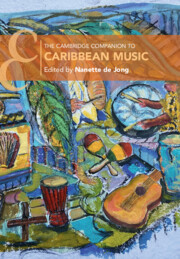Book contents
- The Cambridge Companion to Caribbean Music
- Cambridge Companions to Music
- The Cambridge Companion to Caribbean Music
- Copyright page
- Dedication
- Contents
- Figures
- Contributors
- Foreword
- Acknowledgements
- 1 Introduction to the Caribbean and Its History
- 2 Race and Transculturation
- 3 Salsa Soundings
- 4 Blackness and Identity
- 5 From the Island to Global Stages
- 6 Investigating the Caribbean’s African Past
- 7 Reframing Diasporic Belonging
- 8 Competition, Conflict, and Cooperation
- 9 Uncovering Hidden Histories of Meaning
- 10 The Foundations of Rap Music and Post-colonial Emancipation
- 11 Konpa, Zouk, and the Politics of World Music
- 12 Globalisation in the Reggae and Dub Diaspora
- 13 Musical Orality and Literacy in the Transmission of Knowledge and Praxis
- 14 Narratives of Return
- 15 Decolonising Caribbean Imaginaries
- Index
- References
2 - Race and Transculturation
Cuban Son
Published online by Cambridge University Press: 17 September 2022
- The Cambridge Companion to Caribbean Music
- Cambridge Companions to Music
- The Cambridge Companion to Caribbean Music
- Copyright page
- Dedication
- Contents
- Figures
- Contributors
- Foreword
- Acknowledgements
- 1 Introduction to the Caribbean and Its History
- 2 Race and Transculturation
- 3 Salsa Soundings
- 4 Blackness and Identity
- 5 From the Island to Global Stages
- 6 Investigating the Caribbean’s African Past
- 7 Reframing Diasporic Belonging
- 8 Competition, Conflict, and Cooperation
- 9 Uncovering Hidden Histories of Meaning
- 10 The Foundations of Rap Music and Post-colonial Emancipation
- 11 Konpa, Zouk, and the Politics of World Music
- 12 Globalisation in the Reggae and Dub Diaspora
- 13 Musical Orality and Literacy in the Transmission of Knowledge and Praxis
- 14 Narratives of Return
- 15 Decolonising Caribbean Imaginaries
- Index
- References
Summary
The premise of this chapter is that an examination of the Cuban son provides important insights into Cuban history and society, into Caribbean race relations, and ongoing processes of cultural fusion involving Afro-descendant and Euro-descendant practices, among others. The chapter focuses primarily on early son history, its antecedent forms, the African-influenced aesthetic sense that gave rise to it, and the popularization of the music and dance in the early twentieth century. Later it briefly considers changes to son music in the 1930s and beyond.
Keywords
- Type
- Chapter
- Information
- The Cambridge Companion to Caribbean Music , pp. 18 - 35Publisher: Cambridge University PressPrint publication year: 2022



